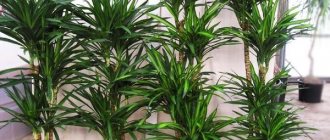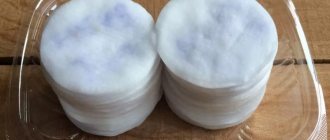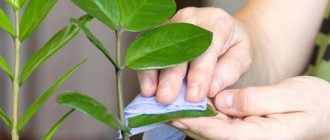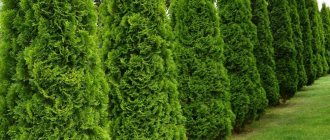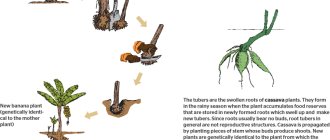Eucalyptus (Eucalýptus) is a genus of plants belonging to the shrubs and trees that belong to the family Myrtaceae. Eucalyptus is native to Australia and the island of Tasmania, but due to its numerous beneficial properties it was introduced and began to be cultivated in many countries.
Eucalyptus got its name thanks to the famous French botanist Charles Louis Léritier de Brutel, who decided to combine two Greek words: “good, good,” pronounced “eu” and “hide,” which corresponded to “calypto.” This desire, unusual at first glance, is easily explained by the plant’s ability to hide its flower buds under the cups of leaves.
Eucalyptus is capable of releasing phytoncides into the air, which kill pathogenic bacteria and viruses, fungi, its foliage contains a large amount of essential oil, which is now successfully extracted and is widely used, and eucalyptus has been planted in many countries with this problem for its ability to drain swampy areas, After all, it is capable of drawing in up to 300 liters of water in just one day! In some areas of Australia, the aborigines believed that even one drop of eucalyptus oil could protect an entire home and all the people in it from evil unclean spirits. Thanks to all this and many other beneficial properties, eucalyptus was nicknamed the “wonderful tree.”
Eucalyptus has a very amazing ability to turn the surfaces of its leaves towards the sun with its ribs, thereby reducing the area of moisture evaporation, which is why the tree survives in hot, arid climates. This feature was also noticed by European colonists in the 18th century, who, having visited eucalyptus forests for a long time, could not understand why such huge trees did not cast an appropriate shadow. The great writer Jules Verne also wrote about this in his work “The Children of Captain Grant.”
In nature, this miracle tree can reach a height of up to a 50-story building, which is no less than 100 m in height, but at home, eucalyptus reaches only 2 m, then they try to limit its growth.
Eucalyptus gunnii.
Description and characteristics of the plant
Lemon eucalyptus (Eucalyptus Citriodora) is an amazing evergreen tree of the Myrtaceae family, which is considered to be native to Eastern Australia. Prefers to grow in warm climates. Under natural growing conditions it can reach 100 m in height. When kept indoors, the height of the plant can be easily adjusted with timely pruning and pinching. The leaves are quite dense, arranged in a spiral on the stems. They have an oval-lanceolate shape, reach 16 cm in length, and no more than 2 cm in width.
Indoor lemon eucalyptus
The bark of a eucalyptus tree is white with red-brown, sometimes orange, streaks. There are small growths at the bottom of the trunk.
Eucalyptus flower in a pot, Blue Baby variety
Types of indoor eucalyptus
On sale you can find 4 types of eucalyptus, each of which has unusual foliage and a spectacular appearance.
Eucalyptus cinerea, or silver dollar
This unusual bright tree is decorated with matte silver egg-shaped foliage. As they grow, the shape of the leaves remains virtually unchanged.
Eucalyptus globulus (Eucalyptus globulus)
The bush has a large number of branches, which are covered with rich green foliage of an elongated lanceolate shape. The bark of this species is pale yellow.
Eucalyptus gunnii (Eucalyptus gunnii)
The species has round light blue leaf blades that have a faint aroma. The leaves turn green only on a mature plant. There are several varieties with smaller foliage and dark green or deep blue color.
Varieties suitable for home cultivation
How to grow a lemon tree from a seed at home
There are many types of eucalyptus (more than 500), but only a few of them are suitable for growing as an ornamental crop. The most popular include:
- globular. It stands out for its beautiful, pyramidal crown and bluish-blue leaves, on the outside of which there is a silvery coating;
- Gunny. Young plants have round, gray-green leaves, which become oblong with a pointed tip as the tree matures;
- Blue baby. Belongs to the dwarf species of eucalyptus. Distinguished by small gray-blue petals;
- fig leaf. It stands out among other varieties due to its rounded small leaves;
- silver or ash. The main difference is the gray oval or round leaves;
- Populus is an ornamental eucalyptus that is capable of forming small berries.
Important! These varieties are not intended for planting in open ground; they can only be grown indoors.
There is also a very beautiful species, the rainbow eucalyptus, which has bark of various colors similar to a rainbow, but it is not suitable for growing as a houseplant.
Varieties of plants in pots on the windowsill
Features of eucalyptus
The natural shape of the crown of eucalyptus trees is pyramidal, and it has a light blue tint. This plant comes from Australia and is widely used to extract valuable essential oil. Eucalyptus is not widely used in home culture. This is due not only to the fact that the culture is quite expensive, but also to its demanding and capricious nature.
Eucalyptus (Eucalyptus) is a slow-growing plant, and it changes almost imperceptibly. At home, the height of the bush, as a rule, does not exceed 100 cm. It can be cultivated both as a tree and as a shrub. In indoor culture, this plant has graceful straight shoots that are decorated with silver-green leaf plates, the shape of which is similar to a coin.
It may seem that the eucalyptus crown is loose; this is due to the unusual arrangement of the leaf plates, which are turned edge-on to the light source. The shiny and smooth surface of the leaf blades is covered with a waxy coating of a bluish-gray hue, which has a spectacular silvery tint. The oval-rounded soft leaf blades have a pungent aroma. After some time, they become stiffer, and also lengthen a little and become slightly sharper.
The tree also stands out for its unusual flowering. Small flowers are formed in the leaf axils, which can be short-petiolate, single, or collected in not very large corymbose inflorescences. The petals of the flowers are fused, and they are decorated with many stamens. Fluffy flowers can be colored yellowish, pale cream or pale pink. In place of pollinated flowers, unusual cone-shaped fruits are formed.
Eucalyptus has powerful phytoncidal properties. In addition, the wonderful smell helps prevent the development of colds, and it also has a pronounced refreshing, tonic and sedative effect. This plant is great for offices and work areas.
We grow eucalyptus at home - Everything will be fine - Issue 97 - 12/17/2012 - Everything will be fine
Medicinal properties
Indoor eucalyptus releases phytoncides that cleanse the air of viruses and bacteria.
How to grow abutilon flower from seeds at home
The leaves contain essential oil that has powerful antibacterial and antiviral properties. The leaves of the plant are used to prepare oils, infusions and alcohol tinctures.
Eucalyptus is a home plant that is often used to treat abscesses, furunculosis, purulent mastitis and various ulcers. Decoctions of eucalyptus leaves can be used for inhalation for acute respiratory infections and gargling for throat diseases and various problems in the oral cavity.
Note! The plant will only be beneficial if you apply eucalyptus leaves and products prepared from them externally in the form of lotions, ointments or rinses. Ingestion may cause poisoning.
Bright green eucalyptus leaves
For your information! Eucalyptus was first grown in Australia at the end of the 18th century. The eucalyptus tree came to Russia thanks to the botanist A. N. Krasnov in the early 80s of the 19th century. It took breeders more than 50 years for it to take root.
Spreading
The homeland of this tree is Australia and all the islands adjacent to it. It is there that you can still find any of the varieties, and more than 500 species grow there. In Australia, this medicinal plant is a forest-forming plant and grows well both in forests and lowlands, as well as on ordinary streets and private plots.
Now eucalyptus has long escaped the territory of Australia and is growing in a number of other countries: India, France, Africa, Portugal, Greece, China, Israel, Russia and so on. But there is one small difference: in the above countries only low-growing analogues grow. The fact is that for rapid growth a tree needs increased moisture.
As for Russia, eucalyptus grows very slowly here, and some species do not take root at all and die. The best place to plant this tree is Sochi.
Home care for eucalyptus as a houseplant
Callistemon lemon: examples of home care
Lemon eucalyptus care at home requires simple care. It consists of ensuring the correct temperature conditions, timely watering, applying the necessary fertilizing, annual replanting and periodic pruning.
Temperature
In summer, the most suitable temperature for eucalyptus is considered to be within 20-25 °C, in winter - 12-16 °C. The tree needs a fresh flow of air, but during the ventilation period in frosty weather it needs to be protected from cold drafts.
Lighting
It is best to place lemon eucalyptus in a pot at home in well-lit places, for example, it could be the windowsill of south, south-east or south-west windows. If all the windows of the apartment face north, it is necessary to use additional lighting, since a lack of light will lead to slow growth of the flower.
In summer, when the weather is good outside, the flower can be taken out onto the balcony or terrace. During heavy rain or wind, it must be taken back to the apartment. With the arrival of autumn, the tree must be returned to the room again.
Lush green bush
Watering
In summer, you need to make sure that the soil in the pot is always moist; you should water the plant once every 2-3 days with a small amount of water. In winter, eucalyptus needs to be watered as the top layer of soil dries out - once every 7-10 days.
Important! For irrigation, use only purified water at room temperature.
Eucalyptus plant species Populus
Humidity
In the summer, indoor eucalyptus needs moist air, but since the plant cannot be sprayed, you can maintain the required level of humidity by placing the pot in a pan of water. In this case, the tree will take as much water as it needs.
Priming
For proper development and good growth, eucalyptus must be planted in soil rich in mineral components. You can buy a ready-made substrate, or you can prepare it at home. The soil composition should include: humus (20%), turf (40%), river sand (20%) and dry peat (20%). The soil should be loose and well drained.
Feeding
During the active growing season, indoor eucalyptus must be fertilized periodically. Complex mineral fertilizers and organic matter can be used as fertilizers. Feeding should be done once every 14-20 days. Fertilizing is carried out immediately after watering. The amount of fertilizer applied is calculated according to the instructions.
Important! You should not fertilize the flower in winter during the dormant period. In addition, it is not recommended to fertilize immediately after transplantation, or if the flower is sick or damaged by pests.
An odorous miracle - the aroma of lemon balm and lemon 2 in 1. How to grow and form a beautiful tree.
Hello, dear sadists and gardeners!
I have been growing plants relatively recently, but I can say that it is very exciting, especially when the result is pleasing to the eye. Therefore, this activity captivated me, especially since the world is full of amazing plants, such as our hero of the review.
I want to share with you my experience of growing such an unusual exotic plant as lemon eucalyptus from seeds. This indoor perennial plant has one distinctive feature - if you crush its leaves, a pleasant smell of lemon appears (with mint or lemon balm, as it seems to me - that's right! It's a mojito.), and it also blooms beautifully - with pleasant yellow hairy flowers.
Sowing
I purchased eucalyptus seeds on the website here. There is even my enthusiastic review about how high the germination rate of the seeds turned out to be. Seeds were bought if someone was interested in the process of growing this miracle from seeds.
I planted the seeds in February, and literally a few days later the first shoots appeared. 5 out of 6 have sprouted! I sowed the seeds in peat tablets. I didn’t expect such good germination, so I placed several seeds in one tablet.
Growth process
Subsequently, those plants that all three sprouted together in one tablet were transplanted into a pot with the same composition. Oddly enough, they turned out to be stronger and denser, and developed faster than the “loners”. Then I also put the single ones together and gave them to a friend. And the triple “mojito” stayed with me and moved to a more convenient and larger pot.
And now, in the fall, my eucalyptus looks like this:
Care and pruning
Caring for this plant is not very difficult; it seemed unpretentious to me. The plant loves the sun and grows actively if it does not lack sun. I have it sitting safely on the south window. However, eucalyptus requires watering much more often than other plants. It drinks very greedily; in the summer it needs to be watered daily. It is extremely undesirable to skip watering, otherwise it begins to droop the leaves, wither, and then the leaves turn yellow and fall off. The appearance begins to deteriorate.
I carried out pruning and shaping of the beautiful plant according to a self-invented and, one might say, intuitive form. Since by chance I had three plants growing in one pot, I decided not to separate them, but rather to make an advantage out of this disadvantage and braided their trunks))) While the plant trunks were young, flexible and pliable, this could be done easily and just. Here's what happened:
Over time, the trunks became thicker and covered with “wood”, and even grew a little together.
Three plants made a dense mini-tree. A single plant would not produce such beauty.
I pinch off the tops and unnecessary side shoots.
Top dressing
I once fed my eucalyptus tree with a regular solution of Gumat+7 fertilizer. Which, it seems to me, had a very beneficial effect on it - the growth and density of the plant accelerated. Side shoots appeared.
Benefit
Some facts about the plant
Thanks to the phytoncides released and the ability of the leaves to evaporate large amounts of water, eucalyptus helps improve indoor air quality. It has a beneficial effect on the psyche, helps with a runny nose, cough, and repels insects: flies, mosquitoes, mosquitoes.
As I already wrote, this variety of eucalyptus has a specific smell due to the high content of essential oils. I really like their scent. Even without all those beneficial properties, I’m just blown away by the smell of a leaf crushed in my hand. The plant is also pleasing to the eye from a purely aesthetic point of view.
Interesting things
➺ Eucalyptus leaves are covered with small “villi”
➺ You can easily overdo it with the smell. If you strongly interact with the leaves, for example when pruning a plant, such a strong aroma is released, to which my husband once said that it smells very sharply and strongly of a star.
➺ The plant really repels insects: before, my cacti were periodically tormented by spider mites, but now, in the vicinity of the eucalyptus, these guests do not visit us. And they will never touch the eucalyptus itself - it’s probably tasteless to them. There are no flies at all, and I don’t see any mosquitoes either.
➺A sufficient percentage of essential oils is contained in the dried leaves of the plant, so they are even added to teas.➺ Eucalyptus blooms in indoor conditions quite rarely. Which is very sad. I really hope that my favorite will please me with yellow furry creatures someday..
I will definitely update this review with new photos of my pet. So if you are interested, follow my review. Here is another review about another exotic - the beautiful Strelitzia, which six months ago became one of my favorites on the windowsill.
Pruning at home
If you do not trim the shoots, the tree will become very tall. To form a lush, beautiful crown, annual spring pruning is carried out. During the pruning process, the central trunk is shortened to the required height. After pruning, the eucalyptus will produce young shoots, forming a lush bush. Young shoots are pinched, this is necessary for the formation of young shoots. Using this method, you can form the crown of a plant of the required size and shape. Mature plants need to have their roots trimmed during transplantation, this will help limit the trunk from stretching in height.
How to propagate yourself
You can grow lemon eucalyptus from seeds, as well as by rooting apical cuttings.
Germination of seeds
How to grow lemon eucalyptus using seeds:
- Place a drainage layer on the bottom of the planting container and soil on top.
- Pour lemon eucalyptus seeds Ozone, lightly pressing them into the ground, water with warm water.
- Cover the container with glass or film and place in a warm place for germination.
- Every day, plantings need to be ventilated, removing the cover and removing accumulated condensation.
- The first shoots can be seen after 7-10 days. When the first shoots hatch, the cover must be removed.
- When 3-4 true leaves appear, pick them out in separate small pots.
- When the young plants grow to a height of 15-20 cm, transplant them into a large pot.
Grown seedling
Rooting cuttings
Step-by-step process of rooting cuttings:
- From an adult plant, several young shoots 10-12 cm long are cut off, and all side leaves are removed.
- The cut is treated with a root growth stimulator.
- The sprouts are planted in prepared soil.
- Cover with film and place in a warm place.
- Rooting will take 3-4 weeks.
- When the cutting takes small roots, it is transplanted to a permanent place.
Do I need to change the water in cuttings?
There is no need to change the water under the cuttings, but only add it if necessary. It is better to put 1 or 2-3 cuttings per 1 glass or jar. Almost all of the cuttings die in large numbers. Place a piece of charcoal or activated charcoal in the water; it will inhibit putrefactive processes.
Interesting materials:
How to download a game to a laptop? How to replace the battery on an Acer laptop? How to replace the battery in a Lenovo laptop? How to replace ssd in laptop? How to Password Protect a Lenovo Laptop? How to password protect a laptop? How to record audio on a laptop? How to record voice on a laptop? How to record a voice message on a laptop? How to record sound on a laptop?
Transfer
During the period of active growth, young eucalyptus requires an annual transplant. The most suitable time for this is spring, when new leaves are actively growing.
Note! Mature plants that are more than three years old are replanted every three years using the transshipment method.
The transplant is done as follows:
- Eucalyptus is watered in advance to make it easier to remove from the old pot.
- Prepare a larger pot.
- A drainage about 5 cm thick is made at the bottom of the container, and a small layer of earth is poured on top.
- The tree is removed from the previous pot, lightly shaking off the old soil from the roots.
- Inspect the entire root system, cutting off all damaged and rotten roots.
- The cut areas are sprinkled with charcoal or activated carbon.
- The plant is placed vertically in the pot and soil is added.
- Water with warm purified water.
An overgrown plant needs a new, spacious pot so that the roots do not suffer due to cramped space. After transplanting or planting, the plant goes through an adaptation period, so it should be removed away from bright sunlight and not fertilized for one week.
Transplantation by transshipment method
Planting and care
It is worth noting right away that it is best to grow eucalyptus not in open ground, but in a pot. This way you can provide it with the necessary moisture, which means it will develop correctly. In open ground, this plant rarely takes root in Russia. If the conditions are not suitable for a tree, then it simply stops in its development. Let's look at the procedure for planting and caring for a tree in more detail.
Landing
The most optimal place for planting eucalyptus is a sunny place; a window sill located on the sunny side is perfect.
Eucalyptus is grown using seeds that ripen in a capsule within one year. But not all seeds will eventually germinate; more than 80% will remain in the soil. You can find out how many trees will appear only after the seeds sprout their first shoots.
Boarding procedure:
drainage is placed at the bottom of the clay pot, which is covered on top with soil with humus and, sometimes, sand; The tree seeds must be planted in moist soil. The air temperature in the room in which the eucalyptus is located should be approximately 18 degrees. There is no need to water the seeds for the first week. In a week the first shoots should begin to appear
At this stage, it is very important to constantly ventilate the room and provide the sprouts with good daylight. Otherwise, they may immediately rot or become moldy; when the sprouts sprout a little (2-3 cm) and the first leaves appear on them, the shoots can be planted individually in small pots (10 cm in diameter)
This must be done very carefully so as not to damage the still immature root.
In warmer days, the pot can be taken outside.
In order for the landing to be successful, you need to know several rules:
- Not all varieties are suitable for such planting. The best variety is Gunny or lemon eucalyptus. They grow to small sizes and take root well at home.
- Despite the fact that this tree is light-loving, the rays of the bright sun can be destructive for young shoots. It is necessary to carefully protect the pot from bright sun.
- It is better to plant the plant immediately after the seeds have been collected, or more precisely (from February to early June). This period is optimal, since the seeds themselves are still fresh, and the sun is not yet shining brightly enough.
Care
Complete care of a eucalyptus tree consists of several procedures, the importance of which is equally important:
Watering. Do not flood or, conversely, dry out the soil. It is necessary to water eucalyptus in the warm season moderately: if the plant is on the sunny side, then once every two days, if in the shade, then once every 3 days. In autumn and winter, the frequency of watering should be reduced to once a week, or even more. In this case, everything depends not on numbers, but on the condition of the soil. Temperature
Maintaining the temperature regime is important not only in the first stages of eucalyptus growth, but also during its active growth. Comfortable temperature for wood is 18 degrees in winter and 13 degrees in summer. Top dressing
Usually, eucalyptus does not need feeding, but this can be done once every two months. To do this, use conventional vitamin and mineral supplements. Trimming. Eucalyptus should not be pruned during the first few years of growth (2-5). Later, it is recommended to prune a fast-growing tree 2 times a year, but no more.
Possible problems during cultivation
Improper care can cause disease and even death of the plant. If the process of caring for eucalyptus is disrupted, the following problems may appear:
- in case of insufficient lighting, the stems will become very tall, the leaves will decrease in size and change their color to a less saturated color. To solve the problem, it is necessary to move the flower to a more illuminated place or organize additional lighting, especially in winter, when daylight hours are short. It is also worth doing in the summer in cloudy weather;
- If there is insufficient watering, the leaves on the eucalyptus will dry out and fall off. In this case, it is necessary to adjust the watering regime;
- direct sunlight on the leaves and insufficient watering can cause burns. During the midday heat, it is worth shading eucalyptus and moisturizing it in a timely manner;
- Excessive moisture can lead to stagnation of water in the soil, rotting of the root system, softness and falling leaves.
Diseases and pests
Due to the high content of phytoncides, lemon eucalyptus is highly resistant to various types of diseases. Also, because of the smell, many pests avoid it. But if the care rules are not followed, spider mites or scale insects may appear. You can fight them with a damp sponge dipped in soapy water. If such actions do not lead to anything, you need to treat the plant with insecticides.
Lemon eucalyptus is a fragrant evergreen that is great for indoor growing and requires little care. It is easy to grow eucalyptus at home, because the rules of care are extremely simple. This flower can create a pleasant aroma in the room and purify the air, as well as quickly cure winter colds.
Diseases and pests
The eucalyptus tree is disease-resistant, and the essential oils it contains repel insects. Despite this, sometimes plant owners face some problems if they are not maintained correctly:
- if yellowing and falling leaves are observed, this is due to watering with too cold or lime water;
- dropping and discoloration of leaves causes rotting due to excessive watering or, conversely, drying out of the earthen clod;
- leaf loss may be due to cold drafts;
- paleness and curling of the deciduous part of the plant occurs due to lack of light (it is better to place the tree near a window with a southern or southeastern orientation).
In addition, if the air in the room is dry, spider mites often appear, which can be combated with the help of professional insecticides . If you have yellow leaves with cobwebs on the inside, you can prepare a homemade insecticide. For this purpose, you need to make a paste of garlic, put it in a small container, and then put it in a pot near the bush. After this, the plant should be covered with a plastic bag and left there for 24 hours.
Thus, eucalyptus is an indoor tree that, in addition to its beautiful appearance, has beneficial properties. If the plant is properly cared for, it will decorate the room and delight its owner with a pleasant aroma for many years.

